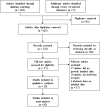Association of homocysteine with type 2 diabetes: a meta-analysis implementing Mendelian randomization approach
- PMID: 24320691
- PMCID: PMC3878883
- DOI: 10.1186/1471-2164-14-867
Association of homocysteine with type 2 diabetes: a meta-analysis implementing Mendelian randomization approach
Abstract
Background: We tested the hypothesis that elevated homocysteine (Hcy) level is causally associated with increased risk of type 2 diabetes mellitus (T2DM).
Results: The meta-analysis and Mendelian randomization analysis were performed among 4011 cases and 4303 controls. The absolute pooled mean Hcy concentration in subjects with MTHFR 677TT was 5.55 μmol/L (95% CI, 1.33 to 9.77) greater than that in subjects with MTHFR 677CC in T2DM. Overall, the T allele of the MTHFR 677 C > T conferred a greater risk for T2DM [Random effect (RE) OR = 1.31(1.17-1.64), I² = 41.0%, p = 0.055]. The random effect (RE) pooled OR associated with T2DM for MTHFR 677TT relative to the 677CC was [RE OR = 1.38(1.18-1.62)]. The fixed-effect pooled OR of the association for the MTHFR 677 TT vs CT was 1.29 (95% CI, 1.09-1.51). MTHFR 677 TT showed a significantly higher risk for T2DM compared with MTHFR 677 CC + CT [Fixed effect (FE) OR = 1.32(1.14-1.54), I² = 0.0%, p = 0.686]. The absolute pooled mean Hcy concentration in individuals with T2DM was 0.94 μmol/L (95% CI, 0.40-1.48) greater than that in control subjects. The estimated causal OR associated with T2DM was 1.29 for 5 μmol/L increment in Hcy.
Conclusions: Our findings provided strong evidence on the causal association of Hcy level with the development of T2DM.
Figures







Similar articles
-
Evidence on the causal link between homocysteine and hypertension from a meta-analysis of 40 173 individuals implementing Mendelian randomization.J Clin Hypertens (Greenwich). 2019 Dec;21(12):1879-1894. doi: 10.1111/jch.13737. Epub 2019 Nov 25. J Clin Hypertens (Greenwich). 2019. PMID: 31769183 Free PMC article.
-
Plausible relationship between homocysteine and obesity risk via MTHFR gene: a meta-analysis of 38,317 individuals implementing Mendelian randomization.Diabetes Metab Syndr Obes. 2019 Jul 23;12:1201-1212. doi: 10.2147/DMSO.S205379. eCollection 2019. Diabetes Metab Syndr Obes. 2019. PMID: 31413611 Free PMC article.
-
Association Between Homocysteine Level and Methylenetetrahydrofolate Reductase Gene Polymorphisms in Type 2 Diabetes Accompanied by Dyslipidemia.Chin Med Sci J. 2020 Mar 31;35(1):85-91. doi: 10.24920/003532. Chin Med Sci J. 2020. PMID: 32299541
-
Associations of common variants in methionine metabolism pathway genes with plasma homocysteine and the risk of type 2 diabetes in Han Chinese.J Nutrigenet Nutrigenomics. 2014;7(2):63-74. doi: 10.1159/000365007. Epub 2014 Jul 25. J Nutrigenet Nutrigenomics. 2014. PMID: 25074646
-
Homocysteine, methylenetetrahydrofolate reductase and risk of schizophrenia: a meta-analysis.Mol Psychiatry. 2006 Feb;11(2):143-9. doi: 10.1038/sj.mp.4001746. Mol Psychiatry. 2006. PMID: 16172608 Review.
Cited by
-
Serum homocysteine level and gestational diabetes mellitus: A meta-analysis.J Diabetes Investig. 2016 Jul;7(4):622-8. doi: 10.1111/jdi.12460. Epub 2016 Jan 20. J Diabetes Investig. 2016. PMID: 27180921 Free PMC article.
-
Association between Hyperhomocysteinemia and Thyroid Hormones in Euthyroid Diabetic Subjects.Biomed Res Int. 2015;2015:196379. doi: 10.1155/2015/196379. Epub 2015 Jun 21. Biomed Res Int. 2015. PMID: 26180785 Free PMC article. Clinical Trial.
-
Impact of single nucleotide polymorphisms (SNPs) in antioxidant-enzyme genes on the concentrations of folate, homocysteine and glutathione in plasma from healthy subjects after folic acid supplementation - a randomized controlled crossover trial.Genes Nutr. 2025 Jan 21;20(1):1. doi: 10.1186/s12263-024-00761-6. Genes Nutr. 2025. PMID: 39838297 Free PMC article.
-
Reduced Levels of H2S in Diabetes-Associated Osteoarthritis Are Linked to Hyperglycaemia, Nrf-2/HO-1 Signalling Downregulation and Chondrocyte Dysfunction.Antioxidants (Basel). 2022 Mar 25;11(4):628. doi: 10.3390/antiox11040628. Antioxidants (Basel). 2022. PMID: 35453313 Free PMC article.
-
Huang-Lian-Jie-Du-Decoction Ameliorates Hyperglycemia and Insulin Resistant in Association With Gut Microbiota Modulation.Front Microbiol. 2018 Oct 8;9:2380. doi: 10.3389/fmicb.2018.02380. eCollection 2018. Front Microbiol. 2018. PMID: 30349514 Free PMC article.
References
-
- King GL, Kunisaki M, Nishio Y, Inoguchi T, Shiba T. et al.Biochemical and molecular mechanisms in the development of diabetic vascular complications. Diabetes. 1996;14:S105–S108. - PubMed
-
- Hoogeveen EK, Kostense PJ, Beks PJ, MacKaay AJC, Jakobs C. et al.Hyperhomocysteinemia is associated with an increased risk of cardiovascular disease, especially in non-insulin-dependent diabetes mellitus - a population-based. Arterioscler Thromb Vasc Biol. 1998;14:133–138. doi: 10.1161/01.ATV.18.1.133. - DOI - PubMed
-
- Kark JD, Selhub J, Bostom A, Adler B, Rosenberg IH. Plasma homocysteine and all-cause mortality in diabetes. Lancet. 1999;14:1936–1937. - PubMed
Publication types
MeSH terms
Substances
LinkOut - more resources
Full Text Sources
Other Literature Sources
Medical

